Resilience Regeneration Priorities for Old Blocks Based on Public Satisfaction: A Case Study of Beijing, China
Abstract
:1. Introduction
1.1. The Important Position of Old Blocks in Cities
1.2. Important Role of Resilience Regeneration
1.3. Important Impact of Public Participation and Satisfaction
2. Materials and Methods
2.1. Satisfaction Three-Factor Theory
2.2. Asymmetric Impact–Performance Analysis (AIPA)
3. Data Collection
3.1. Attribute Identification
3.2. Questionnaire Survey
4. Results Analyses
4.1. Reliability and Validity Tests
4.1.1. Reliability Test
4.1.2. Validity Test
4.2. Exploratory Factor Analysis
4.3. Confirmatory Factor Analysis
4.4. Asymmetric Impact–Performance Analysis
5. Discussion
5.1. Priority Analysis of Resilience Regeneration
5.2. Optimization Strategies of Resilience Regeneration
5.3. Limitations
6. Conclusions
Author Contributions
Funding
Institutional Review Board Statement
Informed Consent Statement
Data Availability Statement
Conflicts of Interest
References
- Li, Q.; Hu, X.; Liu, Y.J. Planning and Design of Protection and Inheritance of Historic Old Town; Metallurgical Industry Press: Beijing, China, 2019. [Google Scholar]
- Pourzakarya, M.; Bahramjerdi, S.F.N. Towards developing a cultural and creative quarter: Culture-led regeneration of the historical district of Rasht Great Bazaar, Iran. Land Use Policy 2019, 89, 104218. [Google Scholar] [CrossRef]
- Li, M.Y.; Liu, J.X.; Lin, Y.F.; Xiao, L.Z.; Zhou, J.P. Revitalizing historic districts: Identifying built environment predictors for street vibrancy based on urban sensor data. Cities 2021, 117, 103305. [Google Scholar] [CrossRef]
- General Office of the Ministry of Housing and Urban-Rural Development of The People’s Republic of China. Notice on the Effectively Strengthening of Historical and Cultural Protection and and Resolutely Stopping Vandalism Activities in Urban Renewal and Renovation. Available online: https://www.mohurd.gov.cn/gongkai/zc/wjk/art/2020/art_17339_246832.html (accessed on 3 August 2020).
- General Office of the Ministry of Housing and Urban-Rural Development of The People’s Republic of China. Notice on Further Strengthening the Protection of Historical and Cultural Blocks and Historic Buildings. Available online: https://www.mohurd.gov.cn/gongkai/zc/wjk/art/2021/art_17339_248953.html (accessed on 18 January 2021).
- General Office of the Communist Party of China Central Committee; General Office of the State Council. Opinions on Strengthening the Protection and Inheritance of History and Culture in Urban and Rural Construction. Available online: https://www.gov.cn/zhengce/2021-09/03/content_5635308.htm (accessed on 3 September 2021).
- Guo, B.; Zhang, L.; Li, Y. Research on the path of residents’ willingness to upgrade by installing elevators in old residential quarters based on safety precautions. Saf. Sci. 2019, 118, 389–396. [Google Scholar] [CrossRef]
- Luo, X.; Ren, M.; Zhao, J.; Wang, Z.; Ge, J.; Gao, W. Life cycle assessment for carbon emission impact analysis for the renovation of old residential areas. J. Clean. Prod. 2022, 367, 132930. [Google Scholar] [CrossRef]
- Huo, X.S.; Xue, H.; Jiao, L.D. Risk management of retrofit project in old residential areas under green development. Energy Build. 2023, 279, 112708. [Google Scholar] [CrossRef]
- Zhang, L.M.; Geng, Y.; Dong, H.J.; Zhong, Y.; Fujita, T.; Xue, B.; Park, H.S. Emergy-based assessment on the brownfield redevelopment of one old industrial area: A case of Tiexi in China. J. Clean. Prod. 2016, 114, 150–159. [Google Scholar] [CrossRef]
- Pan, M.; Song, H.Y. Transformation and upgrading of old industrial zones on collective land: Empirical study on revitalization in Nanshan. Habitat Int. 2017, 65, 1–12. [Google Scholar] [CrossRef]
- Ding, W.; Wei, Q.; Jin, J.; Nie, J.; Zhang, F.; Zhou, X.; Ma, Y. Research on public Space Micro-renewal strategy of historical and cultural blocks in Sanhe ancient town under perception quantification. Sustainability 2023, 15, 2790. [Google Scholar] [CrossRef]
- Su, W.X.; Zhang, L.K.; Chang, Q. Nature-based solutions for urban heat mitigation in historical and cultural block: The case of Beijing Old City. Build. Environ. 2022, 225, 109600. [Google Scholar] [CrossRef]
- Sun, S.M.; Wu, Y.; Zhao, Q. The planning proposal of protection and microcirculation for Old Street blocks—Case of “Changsha city Old Street blocks”. Chin. Overseas Archit. 2014, 6, 108–110. [Google Scholar] [CrossRef]
- Wu, Y.F.; Yang, Y. Study on Treatment of old blocks: The Re-creation of “Implicit in the city” Project in Hefei Shuguang Road. J. Anhui Jianzhu Univ. 2015, 23, 88–92+96. [Google Scholar] [CrossRef]
- Ji, X.; Chai, Q.L.; Wang, K. Research on the strategy of the reorganization and transformation of the old commercial block under the background of open block—A case study of Peixian Han street reconstruction in Xuzhou. Chin. Overseas Archit. 2017, 3, 121–123. [Google Scholar] [CrossRef]
- Liu, M.T.; Wang, G.E. A Study on the Strategy of Block Renovation based on the Concept of Park City: Taking Chengdu Zaozi Alley as an Example. Archit. Cult. 2021, 2, 201–202. [Google Scholar] [CrossRef]
- Xiao, Y.X.; Pan, X.C.; Dong, Z.X. Regeneration Strategy of High-density Old Blocks based on the Idea of Urban Acupuncture: Take the Concept Design of Hong Kong Miao Street as an Example. Archit. Cult. 2022, 7, 157–159. [Google Scholar] [CrossRef]
- Wang, Z.Y.; Li, D.; Li, G. Research on the renewal of public space in the life circle of old blocks with cultural cognition: Take Laodao Nanjie District of Qinhuangdao as an example. Urban Dev. Stud. 2022, 29, 34–39. [Google Scholar] [CrossRef]
- Xian, Z.Y.; Hu, P.; Tang, X.B.; Nie, H.F.; Long, Z.Y. Study on the Renewal of Old Blocks on the Basis of Gene Recognition of Cultural Landscape: A Case Study of Xiancang Lane in Xi’an City. Archit. Cult. 2023, 1, 144–146. [Google Scholar] [CrossRef]
- Li, Q.; Zhong, X.J.; Liu, T. Safety Planning of Green Regeneration of Old Block; Metallurgical Industry Press: Beijing, China, 2020. [Google Scholar]
- Liu, Y.J.; Li, Q.; Li, W.L.; Zhang, Y.; Pei, X. Progress in urban resilience research and hotspot analysis: A global scientometric visualization analysis using CiteSpace. Environ. Sci. Pollut. Res. Int. 2022, 29, 63674–63691. [Google Scholar] [CrossRef]
- Qian, X.S.; Chen, M.F.; Zhao, F.C.; Ling, H. An assessment framework of global smart cities for sustainable development in a post-pandemic era. Cities 2024, 150, 104990. [Google Scholar] [CrossRef]
- Taherkhani, R.; Hashempour, N.; Lotfi, M. Sustainable-resilient urban revitalization framework: Residential buildings renovation in a historic district. J. Clean. Prod. 2021, 286, 124952. [Google Scholar] [CrossRef]
- Yuan, Q.F.; Cai, T.S.; Huang, N. Historical district preservation and renovation from tenacity angle: A comparison between Shantou and Foshan cases. Planners 2016, 32, 116–122. [Google Scholar]
- Ma, Y.H. Evaluation of public space resilience in Pingjiang historic district. Chin. Overseas Archit. 2020, 8, 42–43. [Google Scholar] [CrossRef]
- Zhang, Y.Z.; Liu, Y.W.; Lei, X.L. Study on Planning Strategy of Districts’ Open Space based on Resilient City Perspective. Archit. Cult. 2020, 9, 160–162. [Google Scholar] [CrossRef]
- Yan, C.; Chen, J.T.; Duan, R. Evaluation system for fireproof resilience of urban historical blocks based on pressure-state-response model: A case of Three Lanes and Seven Alleys in Fuzhou City. Sci. Technol. Eng. 2021, 21, 3290–3296. [Google Scholar]
- Han, M.M.; Han, M.J. Resilient planning: Transformation and regeneration of historic districts—A case of the historic district of Jonker street in Malacca. Urban Archit. 2021, 18, 12–14. [Google Scholar] [CrossRef]
- Shen, Z.C. Construction of urban block spatial resilience index system under flood disaster. Value Eng. 2022, 41, 30–32. [Google Scholar]
- Wang, J.; Zhi, T.; Na, J.; Guo, Y.; Han, M.; Zhao, Z. Evaluation method of fire engineering toughness in historical and cultural districts—A case study of Hehuatang historical district in Nanjing. J. Saf. Environ. 2023, 23, 317–325. [Google Scholar] [CrossRef]
- Chu, H.F.; Du, X.M.; Fang, D.Q. Research on the protection strategy of traditional dwellings in historical districts from the perspective of resilience—Taking Guan Zhong folk houses in Beiyuanmen of Xi’an as an example. Intell. Build. Smart City 2023, 4, 16–19. [Google Scholar] [CrossRef]
- Kostas, M. Urban planning and quality of life: A review of pathways linking the built environment to subjective well-being. Cities 2021, 115, 103229. [Google Scholar] [CrossRef]
- Jung, S.O.; Kim, H. Korean police officers’ perceptions of public satisfaction and its effect on their job satisfaction and work performance, 2017. AJMAHS 2017, 7, 307–316. [Google Scholar] [CrossRef]
- Ma, H.; Liu, Y.; Yan, M.; Xi, J. Study on tourist satisfaction with tourism public service based on SEM and IPA models. J. Arid Land Resour. Environ. 2021, 35, 192–199. [Google Scholar] [CrossRef]
- Li, J.; Fu, J.; Gao, J.; Zhou, R.; Wang, K.; Zhou, K. Effects of the spatial patterns of urban parks on public satisfaction: Evidence from Shanghai, China. Landsc. Ecol. 2023, 38, 1265–1277. [Google Scholar] [CrossRef]
- Wu, N.; Bao, C.K.; Ma, W.C. Consistency between environmental performance and public satisfaction and their planning intervention strategies: A policy text analysis of urban Environmental Planning. Sustainability 2023, 15, 4842. [Google Scholar] [CrossRef]
- Shi, J.G.; Dai, X.Y.; Sun, Z.L.; Liu, M.; Tang, D. Exploring the determinants and consequences of public satisfaction with urban waterfronts: A case study of the Xuhui waterfront in Shanghai, China. J. Urban Plan. Dev. 2023, 149, 04023005. [Google Scholar] [CrossRef]
- Mata, P.; Cullano, R.A.; Tiu, A.M.; Gonzales, G.; Selerio, E.; Maturan, F.; Evangelista, S.S.; Burdeos, A.; Yamagishi, K.; Ocampo, L. Public satisfaction with the government’s disaster response during Typhoon Odette (Rai). Int. J. Disaster Risk Reduct. 2023, 84, 103483. [Google Scholar] [CrossRef]
- Kano, N.; Seraku, N.; Takahashi, F.; Tsuji, S. Attractive quality and must-be quality. J. Jpn. Soc. Qual. Control 1984, 14, 147–156. [Google Scholar]
- Caber, M.; Albayrak, T.; Loiacono, E.T. The classification of extranet attributes in terms of their asymmetric influences on overall user satisfaction: An introduction to asymmetric impact-performance analysis. J. Travel Res. 2013, 52, 106–116. [Google Scholar] [CrossRef]
- Zhang, Y.; Cole, S.T. Dimensions of lodging guest satisfaction among guests with mobility challenges: A mixed-method analysis of web-based texts. Tour. Manag. 2016, 53, 13–27. [Google Scholar] [CrossRef]
- Sun, S.; Fang, D.W.; Cao, J. Exploring the asymmetric influences of stop attributes on rider satisfaction with bus stops. Travel Behav. Soc. 2020, 19, 162–169. [Google Scholar] [CrossRef]
- Albayrak, T.; Caber, M. Prioritisation of the hotel attributes according to their influence on satisfaction: A comparison of two techniques. Tour. Manag. 2015, 46, 43–50. [Google Scholar] [CrossRef]
- Ji, X.; Shao, L.; Du, Y. Collaborating with local communities to identify improvement priorities for historic urban landscape based on residents’ satisfaction: An application of asymmetric impact-performance analysis in Dandong, China. Sustainability 2020, 12, 1463. [Google Scholar] [CrossRef]
- Liu, Y.J.; Li, H.M.; Li, W.L.; Wang, S. Renovation priorities for old residential districts based on resident satisfaction: An application of asymmetric impact-performance analysis in Xi’an, China. PLoS ONE 2021, 16, e0254372. [Google Scholar] [CrossRef]
- Martilla, J.A.; James, J.C. Importance-performance analysis. J. Mark. 1977, 41, 77–79. [Google Scholar] [CrossRef]
- Tuan, V.A.; Van Truong, N.; Tetsuo, S.; An, N.N. Public transport service quality: Policy prioritization strategy in the importance-performance analysis and the three-factor theory frameworks. Transp. Res. A 2022, 166, 118–134. [Google Scholar] [CrossRef]
- Quan, L.J.; Kim, J.J.; Han, H. Customer views on comprehensive green hotel selection attributes and analysis of importance-performance. J. Travel Tour. Mark. 2022, 39, 535–554. [Google Scholar] [CrossRef]
- Gai, S.J.; Fu, J.M.; Rong, X.; Dai, L. Users’ views on cultural ecosystem services of urban parks: An importance-performance analysis of a case in Beijing, China. Anthropocene 2022, 37, 100323. [Google Scholar] [CrossRef]
- Ting, S.C.; Chen, C.N. The asymmetrical and non-linear effects of store quality attributes on customer satisfaction. Total Qual. Manag. 2002, 13, 547–569. [Google Scholar] [CrossRef]
- Slevitch, L.; Oh, H. Asymmetric relationship between attribute performance and customer satisfaction: A new perspective. Int. J. Hosp. Manag. 2010, 29, 559–569. [Google Scholar] [CrossRef]
- Matzler, K.; Renzl, B. Assessing asymmetric effects in the formation of employee satisfaction. Tour. Manag. 2007, 28, 1093–1103. [Google Scholar] [CrossRef]
- Tontini, G.; Bento, G.D.S. Integration of customers spontaneous comments with overall assessment of hospitality services. Curr. Issues Tour. 2020, 23, 3025–3033. [Google Scholar] [CrossRef]
- Mikulić, J.P.D.; Prebežac, D. Prioritizing improvement of service attributes using impact range-performance analysis and impact-asymmetry analysis. Managing Service Quality. Manag. Serv. Qual. Int. J. 2008, 18, 559–576. [Google Scholar] [CrossRef]
- Oh, M.J. Prioritizing improvement of attractiveness attributes: Impact range-performance analysis and impact-asymmetry analysis. Int. J. Tour. Hosp. Res. 2017, 31, 67–81. [Google Scholar] [CrossRef]
- Esmaeili Givi, M.; Keshavarz, H.; Kargar Azad, Z. Quality assessment of e-learning website using asymmetric impact–performance analysis and Kano’s customer satisfaction model: A case study based on WebQual 4.0. Inf. Discov. Deliv. 2023, 51, 35–46. [Google Scholar] [CrossRef]
- Albayrak, T.; Caber, M. Destination attribute effects on rock climbing tourist satisfaction: An Asymmetric Impact-Performance Analysis. Tour. Geogr. 2016, 18, 280–296. [Google Scholar] [CrossRef]
- Yuan, J.; Deng, J.; Pierskalla, C.; King, B. Urban tourism attributes and overall satisfaction: An asymmetric impact-performance analysis. Urban For. Urban Green. 2018, 30, 169–181. [Google Scholar] [CrossRef]
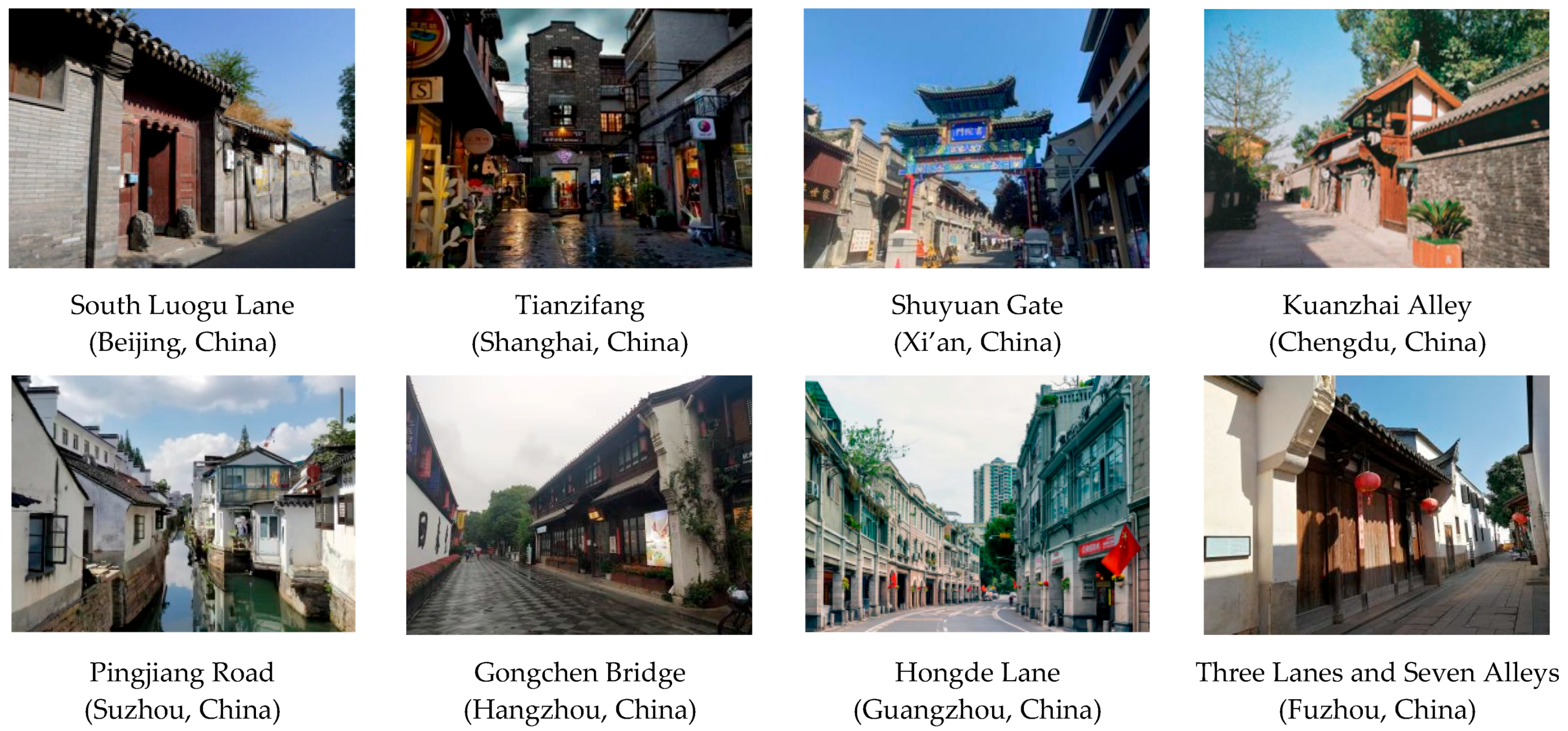
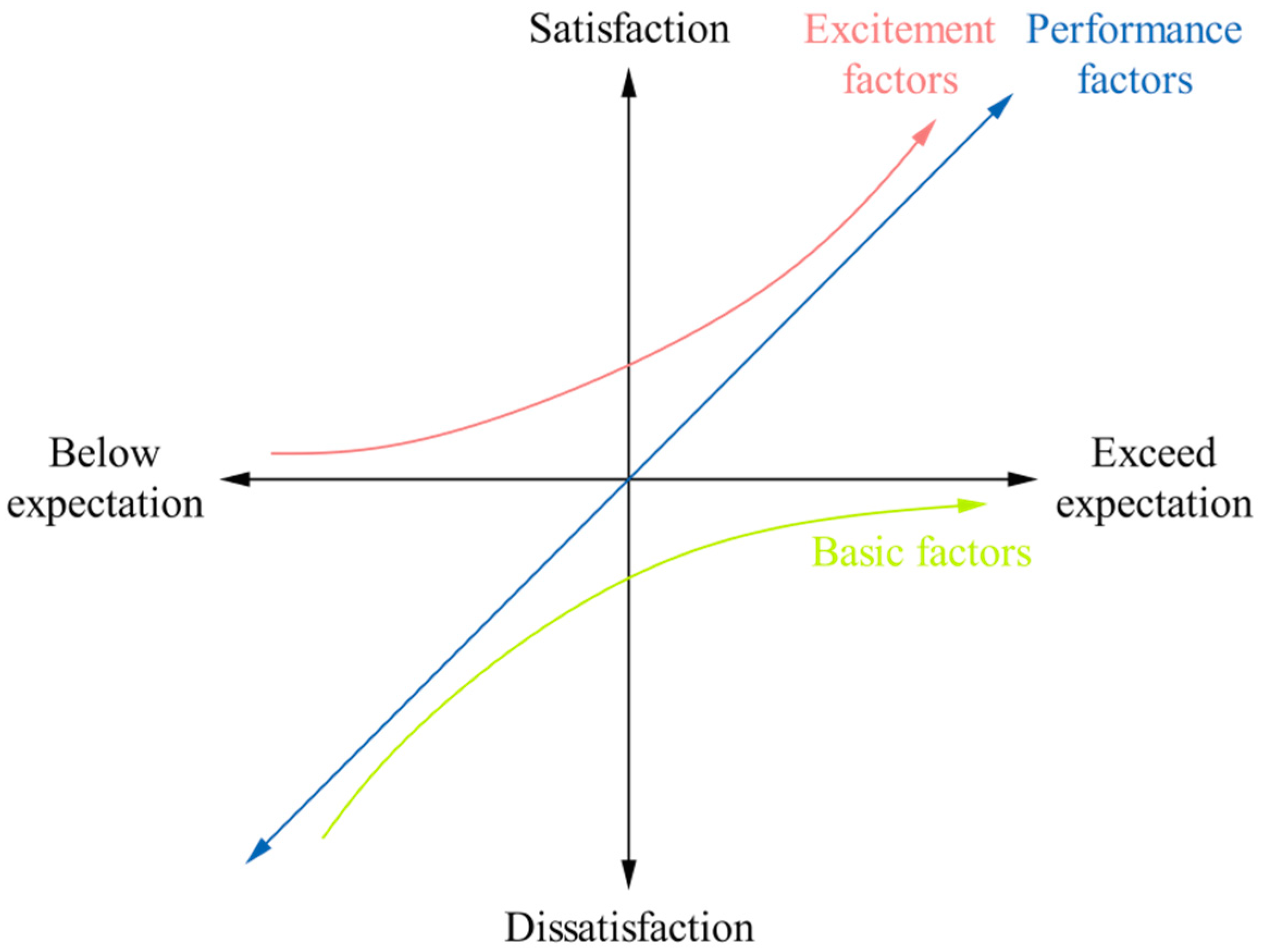
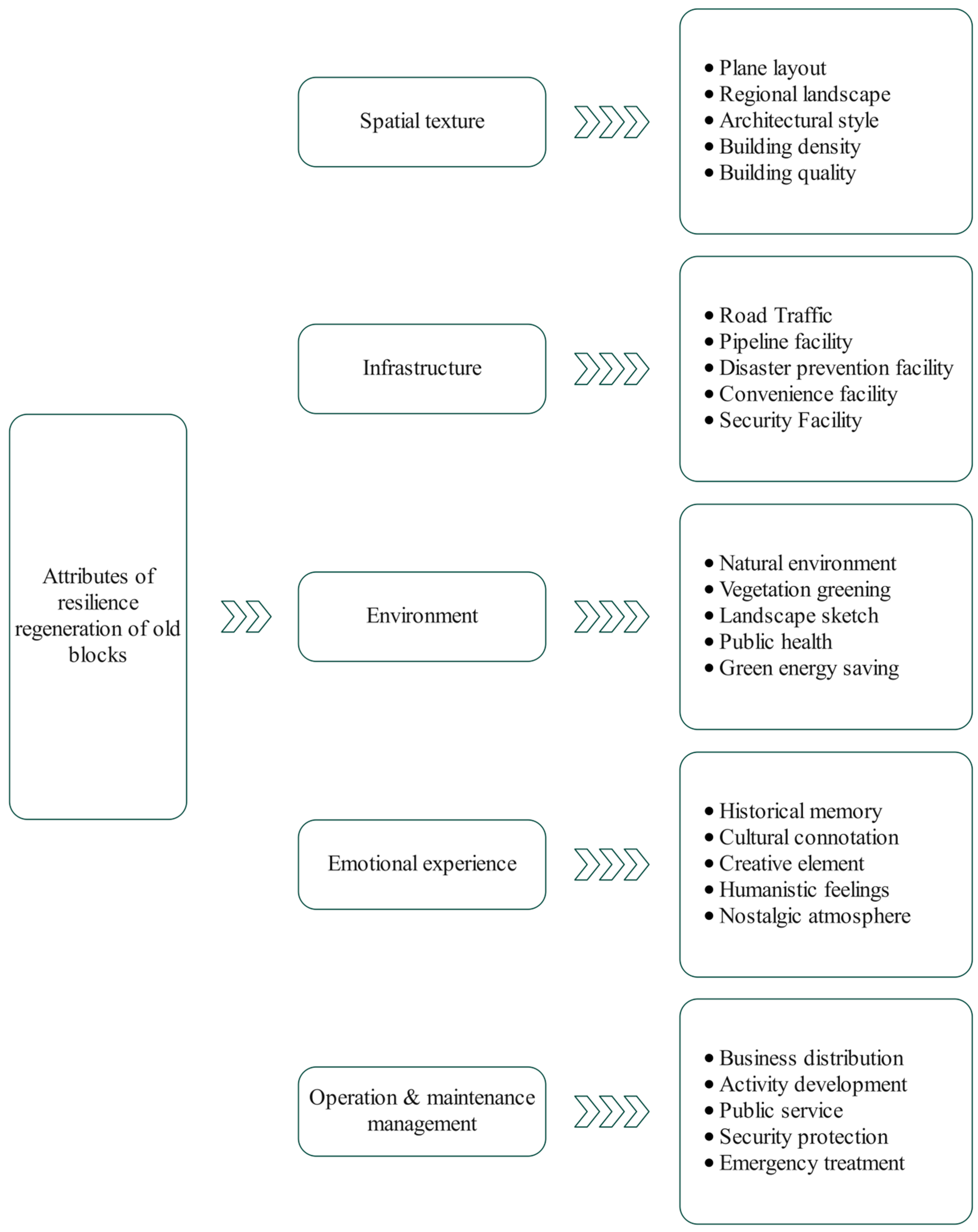
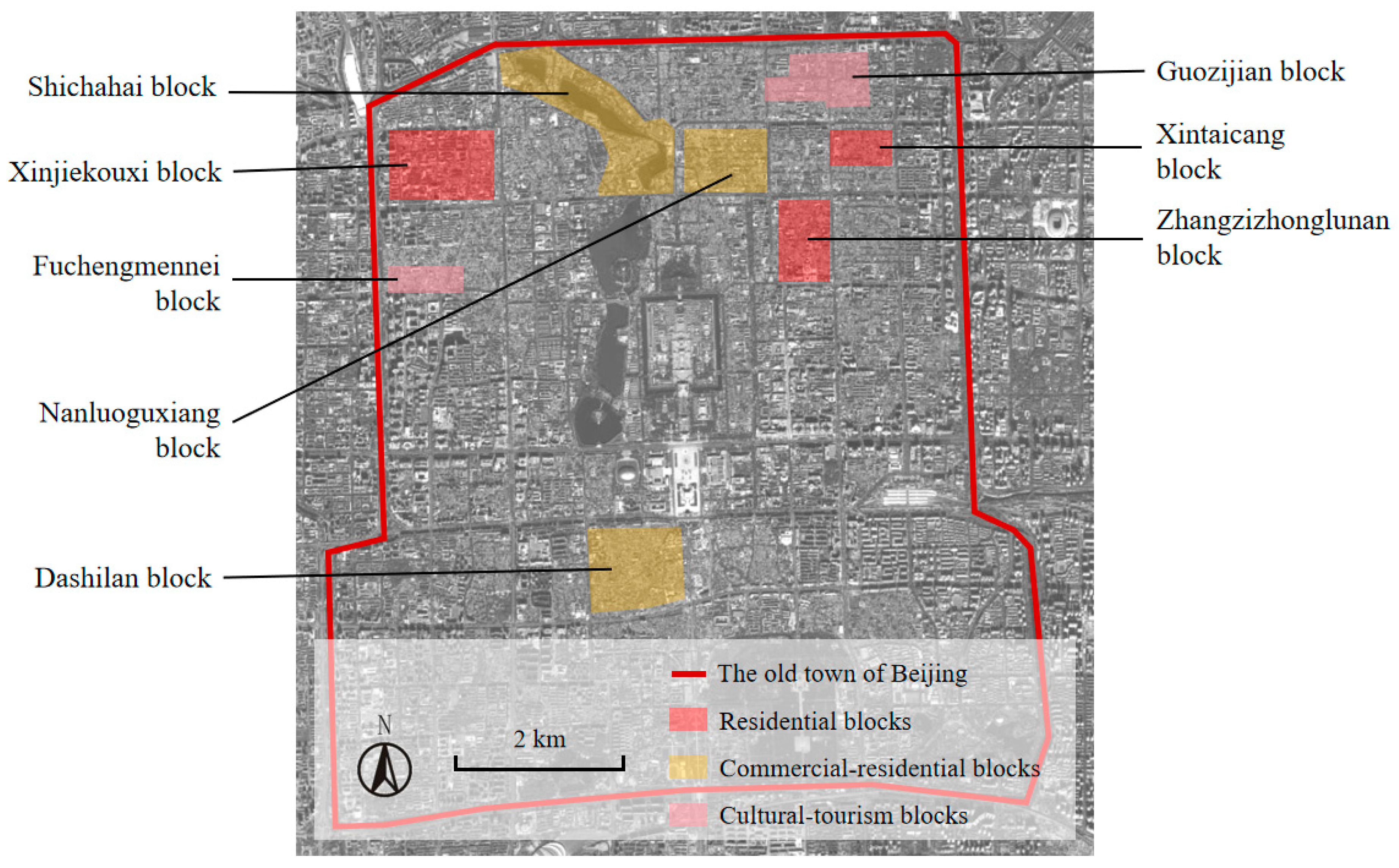
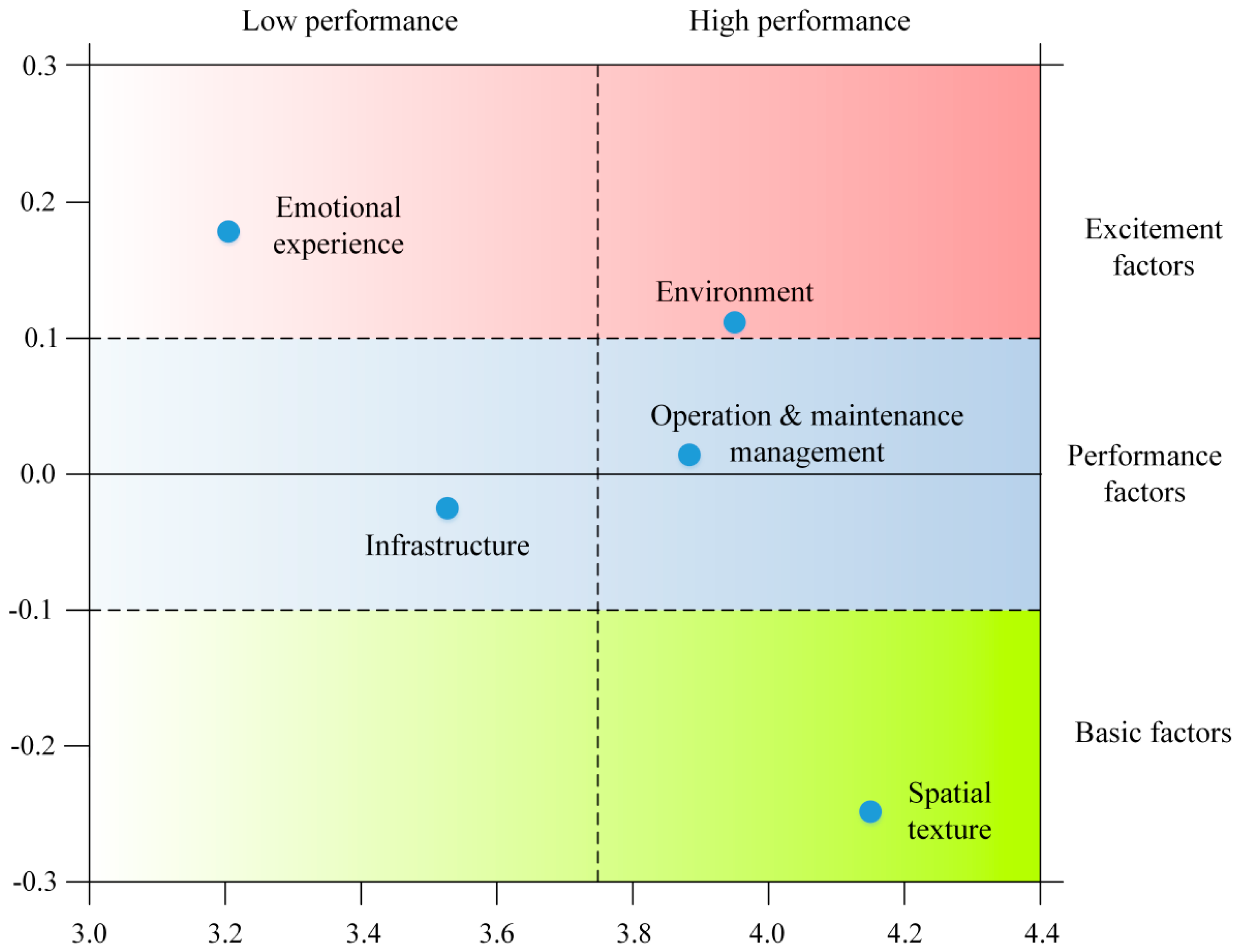
| Items | Categories | Frequency | Percentage |
|---|---|---|---|
| Gender | Male | 87 | 47.03% |
| Female | 98 | 52.97% | |
| Age | 18~35 years old | 54 | 29.19% |
| 36~60 years old | 95 | 51.35% | |
| ≥61 years old | 36 | 19.46% | |
| Education level | High school education and below | 31 | 16.76% |
| Junior college degree | 50 | 27.03% | |
| Undergraduate degree | 63 | 34.05% | |
| Graduate degree | 41 | 22.16% | |
| Personal monthly income | <2500 | 19 | 10.27% |
| 2501~5000 | 65 | 35.14% | |
| 5001~7500 | 56 | 30.27% | |
| 7501–10,000 | 32 | 17.30% | |
| ≥10,000 | 13 | 7.03% |
| First-Level Attribute | Number of Items | Cronbach’s α |
|---|---|---|
| Spatial texture | 5 | 0.923 |
| Infrastructure | 5 | 0.914 |
| Environment | 5 | 0.931 |
| Emotional experience | 5 | 0.886 |
| Operation and maintenance management | 5 | 0.909 |
| Total scale | 25 | 0.917 |
| Testing Coefficient | KMO Value | Bartlett Sphericity Test Value | ||
|---|---|---|---|---|
| Approximate χ2 | df | p | ||
| Testing value | 0.902 | 2357.78 | 276 | 0.000 |
| Fitting Index | χ²/df | GFI | RMSEA | RMR | CFI | NFI | NNFI | IFI |
|---|---|---|---|---|---|---|---|---|
| Judgment criteria | <3 | >0.9 | <0.10 | <0.05 | >0.9 | >0.9 | >0.9 | >0.9 |
| Fitting value | 1.986 | 0.921 | 0.067 | 0.032 | 0.947 | 0.925 | 0.938 | 0.953 |
| Requirements met? | Yes | Yes | Yes | Yes | Yes | Yes | Yes | Yes |
| First-Level Attribute | Regression Coefficient of Dummy Variables | |
|---|---|---|
| Reward Indicator () | Penalty Indicator () | |
| Spatial texture | 0.246 ** | −0.412 ** |
| Infrastructure | 0.531 * | −0.557 ** |
| Environment | 0.758 ** | −0.613 * |
| Emotional experience | 0.489 ** | −0.341 *** |
| Operation and maintenance management | 0.621 *** | −0.598 *** |
| First-Level Attribute | Category | Means | Difference | ||||
|---|---|---|---|---|---|---|---|
| Spatial texture | 0.658 | 0.374 | 0.626 | −0.252 | Basic factor | 4.157 | 0.417 |
| Infrastructure | 1.088 | 0.488 | 0.512 | −0.024 | Performance factor | 3.525 | −0.215 |
| Environment | 1.371 | 0.553 | 0.447 | 0.106 | Excitement factor | 3.941 | 0.201 |
| Emotional experience | 0.830 | 0.589 | 0.411 | 0.178 | Excitement factor | 3.203 | −0.537 |
| Operation and maintenance management | 1.219 | 0.509 | 0.491 | 0.019 | Performance factor | 3.876 | 0.136 |
Disclaimer/Publisher’s Note: The statements, opinions and data contained in all publications are solely those of the individual author(s) and contributor(s) and not of MDPI and/or the editor(s). MDPI and/or the editor(s) disclaim responsibility for any injury to people or property resulting from any ideas, methods, instructions or products referred to in the content. |
© 2025 by the authors. Licensee MDPI, Basel, Switzerland. This article is an open access article distributed under the terms and conditions of the Creative Commons Attribution (CC BY) license (https://creativecommons.org/licenses/by/4.0/).
Share and Cite
Li, W.; Li, Q.; Jia, L.; Hou, D.; Wang, S.; Liu, Y. Resilience Regeneration Priorities for Old Blocks Based on Public Satisfaction: A Case Study of Beijing, China. Buildings 2025, 15, 536. https://doi.org/10.3390/buildings15040536
Li W, Li Q, Jia L, Hou D, Wang S, Liu Y. Resilience Regeneration Priorities for Old Blocks Based on Public Satisfaction: A Case Study of Beijing, China. Buildings. 2025; 15(4):536. https://doi.org/10.3390/buildings15040536
Chicago/Turabian StyleLi, Wenlong, Qin Li, Lixin Jia, Dongchen Hou, Sunmeng Wang, and Yijun Liu. 2025. "Resilience Regeneration Priorities for Old Blocks Based on Public Satisfaction: A Case Study of Beijing, China" Buildings 15, no. 4: 536. https://doi.org/10.3390/buildings15040536
APA StyleLi, W., Li, Q., Jia, L., Hou, D., Wang, S., & Liu, Y. (2025). Resilience Regeneration Priorities for Old Blocks Based on Public Satisfaction: A Case Study of Beijing, China. Buildings, 15(4), 536. https://doi.org/10.3390/buildings15040536






